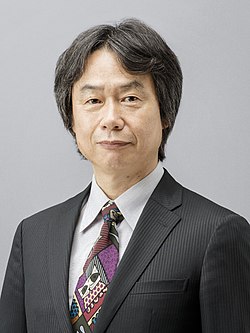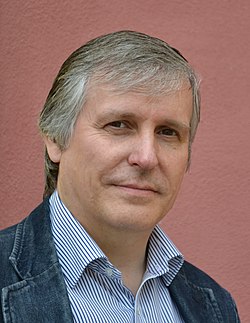Portal:Video games
The Video Games Portal

A video game or computer game is an electronic game that involves interaction with a user interface or input device (such as a joystick, controller, keyboard, or motion sensing device) to generate visual feedback from a display device, most commonly shown in a video format on a television set, computer monitor, flat-panel display or touchscreen on handheld devices, or a virtual reality headset. Most modern video games are audiovisual, with audio complement delivered through speakers or headphones, and sometimes also with other types of sensory feedback (e.g., haptic technology that provides tactile sensations). Some video games also allow microphone and webcam inputs for in-game chatting and livestreaming.
Video games are typically categorized according to their hardware platform, which traditionally includes arcade video games, console games, and computer games (which includes LAN games, online games, and browser games). More recently, the video game industry has expanded onto mobile gaming through mobile devices (such as smartphones and tablet computers), virtual and augmented reality systems, and remote cloud gaming. Video games are also classified into a wide range of genres based on their style of gameplay and target audience. (Full article...)
Featured articles –
Reiche and Ford developed the Ur-Quan based on the concepts for unique spaceships in Star Control; their insectoid appearance was inspired by a National Geographic photo of a caterpillar. Their role in Star Control II has earned acclaim among the best game villains in history, praised for their menacing persona, as well as their surprising depth and humanity. The Ur-Quan have also influenced other game studios, inspiring concepts in games such as Mass Effect and Stellaris. (Full article...)
League of Legends (LoL), commonly referred to as League, is a 2009 multiplayer online battle arena video game developed and published by Riot Games. Inspired by Defense of the Ancients, a custom map for Warcraft III, Riot's founders sought to develop a stand-alone game in the same genre. Since its release in October 2009, League has been free-to-play and is monetized through purchasable character customization. The game is available for Microsoft Windows and macOS.
In the game, two teams of five players battle in player-versus-player combat, each team occupying and defending their half of the map. Each of the ten players controls a character, known as a "champion", with unique abilities and differing styles of play. During a match, champions become more powerful by collecting experience points, earning gold, and purchasing items to defeat the opposing team. In League's main mode, Summoner's Rift, a team wins by pushing through to the enemy base and destroying their "Nexus", a large structure located within.
League of Legends has received generally positive reviews, which have highlighted its accessibility, character designs, and production value. The game's long lifespan has resulted in a critical reappraisal, with reviews trending positively; it is widely considered one of the greatest video games ever made. However, negative and abusive in-game player behavior, criticized since the game's early days, persists despite Riot's attempts to fix the problem. In 2019, League regularly peaked at eight million concurrent players, and its popularity has led to tie-ins such as music, comic books, short stories, and the animated series Arcane. Its success has spawned several spin-off video games, including a mobile version, a digital collectible card game, and a turn-based role-playing game, among others. A massively multiplayer online role-playing game based on the property is in development. (Full article...)
Year of the Dragon received critical acclaim, with reviewers noting how the game successfully built upon the formula of its predecessors. The game sold more than 3 million copies worldwide. Year of the Dragon was the last Spyro title released for the original PlayStation, and the last developed by Insomniac Games due to Universal Interactive Studios and Sony's souring relationship. Year of the Dragon was followed by the multiplatform title Spyro: Enter the Dragonfly, and was later remade as part of the Spyro Reignited Trilogy in 2018. (Full article...)
The team sought to create an immersive world for the player and to compete with the Microsoft Flight Simulator series. Commercially, Flight Unlimited II performed well enough to recoup its development costs. Critics lauded the game's graphics and simulated airspace, and several praised its physics. However, some considered the game to be inferior to Microsoft Flight Simulator 98. Following the completion of Flight Unlimited II, its team split up to develop Flight Unlimited III (1999) and Flight Combat (later Jane's Attack Squadron) simultaneously. Both projects were troubled, and they contributed to the closure of Looking Glass in May 2000. (Full article...)
Development of the game saw considerable work to achieve its presentation. Artwork was conceived by Eoghan Cahill and Neil Breen, who particularly drew the backgrounds in pencil and digitally colored them in Photoshop, the game's design was handled by Tony Warriner and David Sykes, while the game's musical score was composed by Barrington Pheloung. The game was built with Revolution's Virtual Theatre engine, which had already been used by the company in two previous games, Lure of the Temptress and Beneath a Steel Sky.
Broken Sword proved a critical and commercial success following its release on 30 September 1996. Critics lauded praise on the game's story, puzzles, voice acting, writing, gameplay, and music, leading to it receiving numerous award nominations and wins. Sales of the games bested expectations by the company, with around one million units having been sold by 2001. The game has topped several listings of the best adventures games, with many developers citing Broken Sword as an influence in future adventure games. (Full article...)
New Super Mario Bros. released with critical and commercial success, with many considering it as the main contributor in the revival of the 2D platforming genre. Praise went towards the game's improvements and introductions made to the Mario franchise and faithfulness to older Mario games, while criticism was targeted at its low difficulty level and lingering similarities to previous games. It was called one of the best games available for the Nintendo DS by several critics with some further calling it one of the best side-scrolling Super Mario titles. It sold over 30 million copies worldwide, making it the best-selling game for the Nintendo DS and one of the best-selling video games of all time. The game's success led to a line of sequels, starting with New Super Mario Bros. Wii (2009). (Full article...)

Freedom Planet is a 2014 platform video game developed and published by GalaxyTrail. The player controls one of three anthropomorphic animal protagonists: the dragon girl Lilac, the wildcat Carol, or the basset hound Milla. Aided by a duck-like alien named Torque, the girls attempt to defeat the evil Lord Brevon, who plans to steal the Kingdom Stone and conquer the galaxy. While the game focuses on fast-paced platforming, its levels are interspersed with slower action scenes.
Game director Sabrina DiDuro (a.k.a. Strife) first began developing Freedom Planet as a Sonic the Hedgehog fangame using characters created by DeviantArt user Ziyo Ling for its main cast. Early into development, she lost interest in creating a derivative work and reconceived the project as her own intellectual property. Sash Lilac, originally a hedgehog, became a dragon; antagonist Doctor Eggman was replaced by Lord Brevon with his eyebrows resembling Doctor Eggman's mustache; and the Sonic series' ring-based health system was abandoned. Further changes were suggested by fans and incorporated throughout development. Freedom Planet was developed in Denmark and the United States, with its art direction carrying East Asian influences, such as medieval Chinese art inspiring its background visuals.
With development focused on the Windows platform, the game started out as a demo first released in August 2012 and was, after a successful Kickstarter campaign, released in its entirety via Steam in July 2014. Freedom Planet was later released for the Wii U in October 2015, for the PlayStation 4 in 2017, and for the Nintendo Switch in August 2018. The game received largely positive reviews; critics praised its gameplay, visuals, music, aesthetics, sense of humor and balance of Sonic elements with original content, but were mixed on its pacing, voice acting, story and the abundance of long cutscenes. (Full article...)
Did you know... -
- ... that Goodboy Galaxy was the first commercially released video game for the Game Boy Advance in more than 13 years?
- ... that Paul Dini was a writer for both the animated television series Batman: The Animated Series and the video game series Batman: Arkham?
- ... that when Kaz Ayabe pitched his video game Boku no Natsuyasumi to Sony, he said that illustrator Mineko Ueda was interested in the project even though they had never actually met?
- ... that players of the simulation video game Overcrowd: A Commute 'Em Up need to manage everything from the construction of train stations to dumping trash cans?
- ... that a pink skin for Mercy in the video game Overwatch helped raise more than $12 million for breast cancer research?
- ... that Kim Kitsuragi was praised as one of the best video game characters of 2019?
- ... that the urban legend Herobrine was ranked on a Guinness World Records poll of the best video game villains, despite never existing?
- ... that the web-based video game Moderator Mayhem was based on a card game meant to demonstrate the difficulties of content moderation?
- ... that Rawson Stovall became the first nationally syndicated video game journalist in the United States when he was only eleven years old?
- ... that the 1979 video game Superman was one of the first console games with a pause feature?
- ... that Elena from the video game series Street Fighter uses a capoeira fighting style, for which the development team used travel videos as reference material as they had no experience with the style?
- ... that, near the ending of the 2005 interactive storytelling video game Façade, two characters portrayed through AI chatbots ask the player for relationship advice?
Selected biography –
Selected image -

Recent video game-related events
- April 4, 2025 – Tariffs in the second Trump administration
- Multiple companies, including Klarna, StubHub, Nintendo, and Professional Sports Authenticator, pause price-sensitive business actions in the U.S. to evaluate the impact of the recent tariff announcements. (The Wall Street Journal) (IGN) (The Verge)
- January 16, 2025 –
- Nintendo officially reveals the Nintendo Switch 2 video game console, the successor to the Nintendo Switch. (Nintendo)
- September 12, 2024 – 2023–2024 video game industry layoffs
- Microsoft announces that it will lay off 650 Microsoft Gaming employees as part of cuts to its workforce. (Variety)
Topics
Categories
Things you can do
In other Wikimedia projects
The following Wikimedia Foundation sister projects provide more on this subject:
-
Commons
Free media repository -
Wikibooks
Free textbooks and manuals -
Wikidata
Free knowledge base -
Wikinews
Free-content news -
Wikiquote
Collection of quotations -
Wikisource
Free-content library -
Wikiversity
Free learning tools -
Wiktionary
Dictionary and thesaurus














































